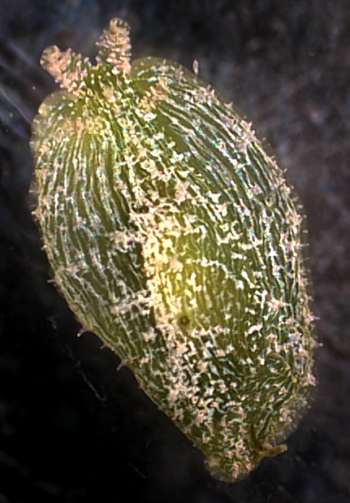
Phyllaplysia engeli
Marcus, 1955
Order: ANASPIDEA
Superfamily: APLYSIOIDEA
Family: Aplysiidae
DISTRIBUTION
Brazil to Caribbean
PHOTO
Tampa Bay, Florida, USA. Photo: Nicholas Curtis
Animal flattened as typical for the genus and very cryptic on the leaves of marine plants on which it is found. Colour translucent with spotting and patching of pink, brown, white and shades of green, the proportions varying between animals. Some species have white longitudinal lines, and some have low papillae. They grow to at least 15mm long.
Note: I suspect this animal is Phyllaplysia engeli which is widespread in the warm water western Atlantic from Brazil to the Caribbean. However Kerry Clark (1977) described a second species from Florida, Phyllaplysia smaragda which may be this animal. Clark notes a number of anatomical differences which I obviously can't compare, and a few external differences. In particular he described P. engeli as having a rounded body while P. smaragda was elongated. He also described the oral tentacles of P. engeli to be flattened and distinctly separated while those of P. smaragda were rounded and joined at the base. Unfortunately in this photo the animal seems to be rounded as in P. engeli but has oral tentacles that fit the description of P. smaragda.
References:
• Clark, K.B. (1977) Phyllaplysia smaragda (Opisthobranchia: Notarchidae), a new anaspidean from Florida. Bulletin of Marine Science, 27(4): 651-657.
• Marcus, Er. (1955) Opisthobranchia from Brazil. Boletim da Faculdade de Filosofia, Ciencias e Letras. Universidade de Sao Paulo, Zoologia, 20: 89-261. (Pls. 1-30)
• Marcus, Ev. (1972) On the Anaspidea (Gastropoda: Opisthobranchia) of the warm waters of the western Atlantic. Bulletin of Marine Science, 22(4): 841-874.
• Marcus, Ev. & Hughes, H.P.I. (1974) Opisthobranch mollusks from Barbados. Bulletin of Marine Science, 24(3): 498-532.
• Redfern. C., 2001. Bahamian Seashells: a Thousand Species from Abaco, Bahamas.
Rudman, W.B., 2004 (January 12) Phyllaplysia engeli Marcus, 1955. [In] Sea Slug Forum. Australian Museum, Sydney. Available from http://www.seaslugforum.net/find/phylenge
Related messages
Re: Phyllaplysia smaragda or P. engeli from Florida
July 9, 2008
From: Geoffrey Smith
Concerning message #21684:
Dear Bill,
Thanks for the confirmation of the genus for this specimen. I have observed several shades of green in these organisms and I have seen the papillae being black in color (as the one pictured) and also lacking the black color. I suspect these are probably just variations in color of the same species or I suppose both species could be present if these are indeed separate species. Whatever the case I am happy in confirming at least a genus.
Thanks again.
Geoff
geoffreyhsmith@gmail.com
Smith, G.H., 2008 (Jul 9) Re: Phyllaplysia smaragda or P. engeli from Florida. [Message in] Sea Slug Forum. Australian Museum, Sydney. Available from http://www.seaslugforum.net/find/21690Dear Geoff,
I am not sure how interested you are in sorting out this problem but if there are two species, it's possible that you will come across them both in your fieldwork. If I were trying to sort it out I would start looking for patterns. Are some fat and rounded and others more slender? or do individuals change from fat to slender as they crawl about? And is the reported difference in the oral tentacles [joined at the base or separate] a real difference or again dependent on whether the animal is contracted or extended? I think colour is likely to be so variable that it is not going to be valuable, but it may be worth noting some basic features such as colour of papillae if present, whether there are spots and their colour, and whether there are lines of any colour. You would need to preserve specimens for anatomical comparisons. It may take a couple of years or even more to build up a big enough sample, but by then you would hopefully have enough observations and specimens to determine whether there were any obvious matching of colour patterns and aspects of the external shape.
The ideal way would be to take good photos - as in your last message - and keep individuals or groups of very similar individuals preserved separately so that if you later wished to compare their anatomies, or give them to someone else to look at their anatomy, any internal differences could be matched with external characters.
Of course there is always the possibility that there are two species but your sampling only includes one species - but that's always a possibility when we are trying to rediscover and redefine species which were badly defined in the first place. If this is far beyond your interests, hopefully it will inspire someone else to take up the question of how many species of Phyllaplysia there are in the Caribbean. I have included the relevant scientific literature on the species Fact Sheet.
Best wishes,
Bill Rudman
Phyllaplysia smaragda or P. engeli from Florida
July 8, 2008
From: Geoffrey Smith Jr.
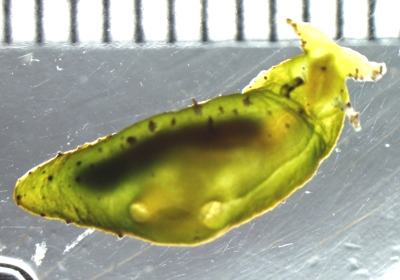
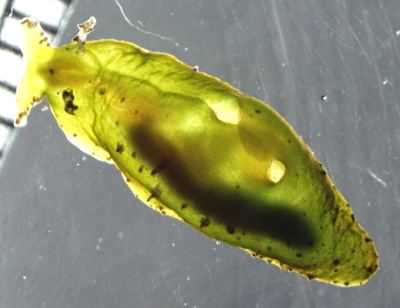
Dear Bill
This is another sea slug I have found several times over the past few years in Sarasota, Florida. It is semitransparent and light green in color, and an inch or less in length. All of the specimens I have collected were in dip nets being pushed across shallow seagrass beds consisting mainly of Thallasia testudinum and Syringodium filiforme. I believe it may be a species of Phyllaplysia.
Locality: New Pass in Sarasota, 2-5 feet, Florida, United States, Gulf of Mexico, several time in 2007 and 2008, seagrass bed. Length: an inch or less (1 mm increments on scale bar in pics). Photographer: Geoffrey Smith.
Geoff
geoffreyhsmith@gmail.com
Smith, G.H., 2008 (Jul 8) Phyllaplysia smaragda or P. engeli from Florida. [Message in] Sea Slug Forum. Australian Museum, Sydney. Available from http://www.seaslugforum.net/find/21684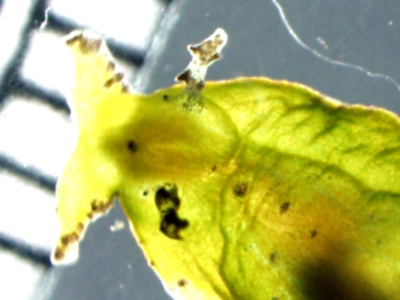
Dear Geoff,
I would agree that this is a species of Phyllaplysia but I have a problem with identifying it to species. Two species, P. engeli and P. smaragda have been reported from the Caribbean and they are reported to have some anatomical differences, but I doubt if enough specimens have been studied to determine whether these differences are inter or intra-specific in importance, or even based on distorsions during preservation. For example P. engeli has a crop between the buccal bulb and gizzard while P. smaragda doesn't and P. smaragda is said to have fewer spines on the penis. In external shape P. smaragda is said to be more elongate and have the oral tentacles joined at the base while in P. engeli the oral tentacles are said to be more separate and the body shorter and rounder, which are both variable characters dependent on whether the animal is extended crawling or sitting at rest.
Colour is very difficult to use as a character in these animals because it is variable and can be affected by the colour of the plant material being eaten. Kerry Clark observed green P. smaragda going reddish-brown after a few weeks in an aquarium feeding on reddish algal growths on the aquarium wall (Clark, 1977).
The uniform green colouration of your animals, and their blackish papillae don't fit the colour information we have on either of the Caribbean species, but I suspect it is just the normal colour variation of one species. Since the earliest name is P. engeli, that is the one I will use until a more comprehensive study on anatomical and colour variability is undertaken. Kerry Clark reported P. smaragda living on Syringodium and concluded its diet consisted of Erythrocladia subintegra, which lives on Syringodium, and scrapings of Syringodium, but as I mention above, it also in aquarium conditions can feed on other algae.
-
Clark, K.B. (1977) Phyllaplysia smaragda (Opisthobranchia: Notarchidae), a new anaspidean from Florida. Bulletin of Marine Science, 27(4): 651-657.
Bill Rudman Rudman, W.B., 2008 (Jul 8). Comment on Phyllaplysia smaragda or P. engeli from Florida by Geoffrey Smith Jr.. [Message in] Sea Slug Forum. Australian Museum, Sydney. Available from http://www.seaslugforum.net/find/21684
Phyllaplysia engeli from Florida
January 29, 2005
From: William Schill
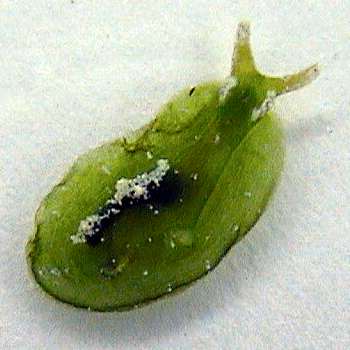
Can anyone who can attach a name to these green guys? I think the egg cases belong to them, but that is still under investigation. These were introduced into our system from Thallasia bed material. Adults and the presumptive egg cases are found on Thallasia as well as Halodule.
Locality: Barnes Key, Florida Bay, Florida, USA
Depth: 1 meter. Length: Up to 1.5 cm. January 2005
Shallow bay waters. Photographer: James Murray
William B. Schill
bane_schill@usgs.gov
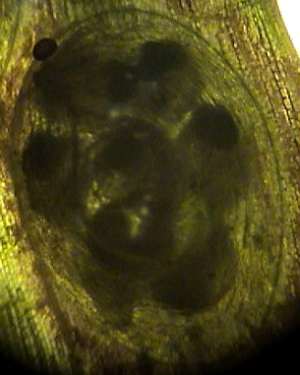
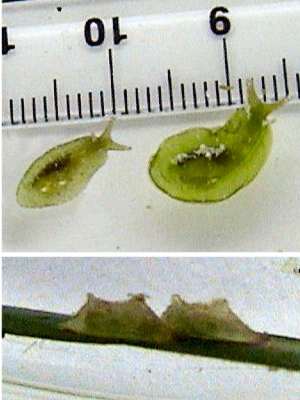
Dear Bane,
This is a small Sea Hare, almost certainly a species of Phyllaplysia. I suspect it is Phyllaplysia engeli, but as I discuss on the Fact Sheet, another species P. smaragda has been described from Florida, but I am not sure if they are really different or not. P. engeli was originally described from 'brown animals with a greenish tinge' from Brazil, but as species in this group can be very variable in colour - from brown to green - I don't think the fact that tour animals are quite green is a real problem. If you plan to study the biology of these animals please keep in touch and let us know how you get on
Best wishes,
Bill Rudman
Phyllaplysia from Tampa Bay, Florida
January 14, 2004
From: Nicholas Curtis

Dr. Rudman,
This little guy was found on a batch of sea grass (Thallassia testudinum) collected in shallow water near the sunshine skyway in Tampa Bay [Florida, USA] by Jen Sneed. The slug appears to have two sets of rhinophores, and, although very difficult to see, appears to have a posterior mantle cavity. I was wondering if you could assist us with its identification.
Thank you
Nicholas Curtis
Department of Biology, SCA 110
University of South Florida
4202 East Fowler Avenue
Tampa, Florida 33620
USA
ncurtis2@helios.acomp.usf.edu
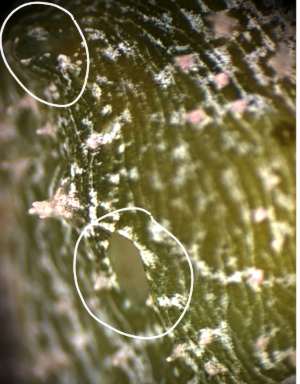

Dear Nicholas,
This is a cryptic Sea Hare of the genus Phyllaplysia and name which can be translated as 'leaf sea hare' for obvious reasons. The two pairs of rhinophores you describe are in fact an anterior pair of oral tentacles and a posterior pair of smaller rhinophores. You are correct in identifying the posterior mantle cavity. In the lower left photo I have ringed the inhalent and exhalent openings into the mantle cavity which is almost completely enclosed by the parapodia which are fused except for the flap region in your photo. There is sometimes a small platelike shell remnant in the mantle cavity but in some animals this is absent.
I suspect your animal is Phyllaplysia engeli which is widespread in the warm water western Atlantic from Brazil to the Caribbean. However Kerry Clark (1977) described a second species from Florida, Phyllaplysia smaragda which may be this animal. Clark notes a number of anatomical differences which I obviously can't compare, and a few external differences. In particular he described P. engeli as having a rounded body while P. smaragda was elongated. He also described the oral tentacles of P. engeli to be flattened and distinctly separated while those of P. smaragda were rounded and joined at the base. Unfortunately in your photo the animal seems to be rounded as in P. engeli but have oral tentacles that fit the description of P. smaragda.
At present I can only say it is a species of Phyllaplysia. I think it will need someone with local knowledge of these species to identify it to species. It is of course possible that P. smaragda is a variety of P. engeli, but again someone would need to study populations of both to sort this out. Certainly both species occur in Florida.
If you can give me some information on when the animal was collected and its size that would be useful
• Clark, K.B. (1977) Phyllaplysia smaragda (Opisthobranchia: Notarchidae), a new anaspidean from Florida. Bulletin of Marine Science, 27(4): 651-657.
Best wishes,
Bill Rudman
